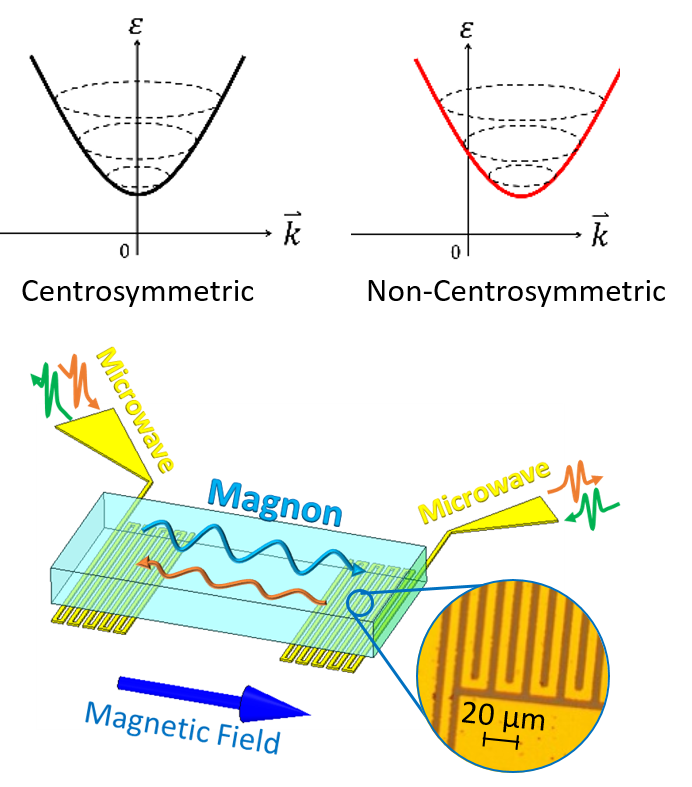Unraveling Non-reciprocity in Spin Dynamics
日本語/English
Macroscopic responses observed in solids have always been supported by the symmetry breaking in a state of matter.
For example, piezoelectricity and natural optical activity emerge in spatial-inversion symmetry (SIS) broken
materials. Time-reversal symmetry (TRS) breaking induces the Hall effect and Faraday effect. It turned out recently
that there is a class of systems that require the breaking of both SIS and TRS in materials. The breakthrough is
provided by the discovery of the magnetically induced ferroelectrics (multiferroics). Several developments followed
such as magnetoelectric effect, a variation of the magnetization induced by the electric field and the electric
polarization controlled by the magnetic field. The breaking of both SIS and TRS also affects the dynamics of
elementary excitations; the energy and decay rate of wave vector $+k$ become not equivalent to those of $-k$. This
phenomenon is non-reciprocity. The non-reciprocity is nontrivial, because the origin is intrinsic interactions
appearing only in both SIS and TRS broken materials such as the spin-orbit interaction. We have focused on the non-reciprocal phenomena relevant to magnon excitation, and studied the non-reciprocity of the microwave near magnon excitation frequency in the non-centrosymmetric magnets.
Non-reciprocal magnon propagation
Spintronics and spin related physics have been attracting much attention recently. There are several important ingredients in this research field. Spin current is essential concept to understand spin transports in nano-scale magnetic devises such as the tunnel magnetoresistance (TMR) device. While the spin current is usually carried by electronic carriers, the spin current driven by magnetic excitations (magnons) is also important for spin transports in magnetic materials. Recently, numbers of novel phenomena related to the magnons have been reported, e.g. spin Seebeck effect, spin wave Doppler effect, and magnon Hall effect. Spintronics related to the magnons is denoted as "magnonics" and thought to be one of the priority research fields near future.
Relativistic spin-orbit interaction is another key ingredient. The spin Hall effect is induced by the spin-orbit interaction, which is useful conversion from charge current to spin current. The modification of band structure owing to the spin-orbit is also important. One of the examples is Rashba effect, which is the spin-splitting depending on the momentum direction. The Rashba spin-orbit interaction can be utilized for the spin field effect transistor.
We have reported that the non-reciprocal microwave response induced by the asymmetric magnon band in a non-centrosymmetric ferromagnet LiFe$_5$O$_8$, which originates from the relativistic Dzyaloshinskii-Moriya interaction. [1] This result clearly demonstrates that the concept of relativistic band modification is also applicable to magnons in ferromagnets, and useful for designing microwave devices.
Microwave non-reciprocity in Multiferroics
We focused on non-reciprocal phenomena related to magnon excitations in the microwave region, particularly studying the external field control of non-reciprocal microwave responses occurring near the magnon excitation frequency.
Magnetoelectrical control of non-reciprocal microwave response in a multiferroic helimagnet
The non-reciprocity has been extensively investigated in visible, X-ray, terahertz, and microwave regions. We demonstrate, for the first time, the control of microwave non-reciprocity with use of external electric and magnetic fields in a multiferroic helimagnet [2]. In the microwave region, more conventional non-reciprocity can be induced by the asymmetric configuration of centrosymmetric ferromagnet in microwave circuits. This mechanism is utilized for important microwave components such isolators, in which the microwave propagation is forbidden in one direction but possible in the other. While the forbidden direction of commercial isolators cannot be changed after the fabrication, our result clearly shows that controllable isolators can be realized with use of a multiferroic helimagnet.
We demonstrated that the multiferroic helimagnet Ba$_2$Mg$_2$Fe$_{12}$O$_{22}$ has the conical magnon excitation in the microwave region.[2] In the microwave region, the type-II multiferroics Ba$_2$Mg$_2$Fe$_{12}$O$_{22}$ shows the optical magnetoelectric effect at 6 K. In addition, the amplitude and the sign of the non-reciprocity of microwave can be controlled by the poling electric field.
We also investigated the nonreciprocity of microwave absorption in the room temperature multiferroic helimagnet BaSrCo$_2$Fe$_{11}$AlO$_{22}$ [4]. We observed that nonreciprocal microwave absorption at 6-20 GHz at room temperature, the sign of which can be controlled by the poling electric field. Such microwave properties will open the avenue of practical applications for future wireless communications.
Microwave non-reciprocity of magnon excitations in a non-centrosymmetric antiferromagnet
Antiferromagnetic spintronics has been attracting much attention, because it does not have large magnetization and appropriate for nano-devices. In contrast to the magnon excitations in magnets with the finite magnetization, such as ferromagnets and conical magnets, the antiferromagnetic magnon excitation tends to need high frequency and high field for observation. In order to scrutinize the magnetic field dependent antiferromagnetic magnon modes and their non-reciprocal directional dichroism, here we chose Ba$_2$MnGe$_2$O$_7$, which has the low Néel temperature $T_N$ and small anisotropy, as a sample and have investigated the magnon excitations in the microwave region.[3]
The multiferroic antiferromagnet Ba$_2$MnGe$_2$O$_7$ has the conventional antiferromagnetic magnon modes with easy
plane anisotropy in the microwave region. The fitting of experimentally observed magnetic field dependence of
these modes to the theoretical equation provides the exchange interaction constant and the magnetic anisotropy
of Ba$_2$MnGe$_2$O$_7$. We observed the microwave non-reciprocity of one of the magnon modes. The microwave non-reciprocity is quantitatively explained by using the spin wave theory, the Kubo formula, and the metal ligand
hybridization mechanism.



![Observed microwave transmittances owing to magnon propagation in LiFe$_5$O$_8$ and Y$_3$Fe$_5$O$_{12}$. The non-reciprocity was only observed in LiFe$_5$O$_8$ and reversed by reversing magnetic field. Reprinted figure from [1]. Copyright 2015, by American Physical Society.](https://51dd2b67fa.cbaul-cdnwnd.com/f71294a23855fe4b3c820bdd9bdfc7c5/200000087-9573795739/nonreci-magnon-result.png?ph=51dd2b67fa)
![Reprinted figures from [2]. Copyright (C)2017, Rights Managed by Nature Publishing Group.](https://51dd2b67fa.cbaul-cdnwnd.com/f71294a23855fe4b3c820bdd9bdfc7c5/200000088-8748287484/nonreci-uwave-mecontrol.png?ph=51dd2b67fa)
![Reprinted figures from [4]. Copyright (C)2022 Author(s). Published under an exclusive license by AIP Publishing.](https://51dd2b67fa.cbaul-cdnwnd.com/f71294a23855fe4b3c820bdd9bdfc7c5/200000124-023190231c/RTmicrowaveNDD.png?ph=51dd2b67fa)
![Reprinted figure from [3]. Copyright 2018, by American Physical Society.](https://51dd2b67fa.cbaul-cdnwnd.com/f71294a23855fe4b3c820bdd9bdfc7c5/200000089-6b3e36b3e5/nonreci-uwave-afm.png?ph=51dd2b67fa)